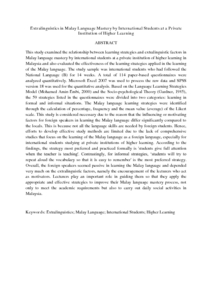Citation
Subramaniam, Vijayaletchumy and Salleh, Che Ibrahim and Yong, Chyn Chye
(2013)
Extralinguistics in Malay language mastery by international students at a private institution of higher learning.
Australian Journal of Basic and Applied Sciences, 7 (9).
pp. 174-181.
ISSN 1991-8178
Abstract
This study examined the relationship between learning strategies and extralinguistic factors in Malay language mastery by international students at a private institution of higher learning in Malaysia and also evaluated the effectiveness of the learning strategies applied in the learning of the Malay language. The study sample was international students who had followed the National Language (B) for 14 weeks. A total of 114 paper-based questionnaires were analyzed quantitatively. Microsoft Excel 2007 was used to process the raw data and SPSS version 18 was used for the quantitative analysis. Based on the Language Learning Strategies Model (Mohamed Amin Embi, 2000) and the Socio-psychological Theory (Gardner, 1985), the 59 strategies listed in the questionnaires were divided into two categories: learning in formal and informal situations. The Malay language learning strategies were identified through the calculation of percentage, frequency and the mean value (average) of the Likert scale. This study is considered necessary due to the reason that the influencing or motivating factors for foreign speakers in learning the Malay language differ significantly compared to the locals. This is because not all the language skills are needed by foreign students. Hence, efforts to develop effective study methods are limited due to the lack of comprehensive studies that focus on the learning of the Malay language as a foreign language, especially for international students studying at private institutions of higher learning. According to the findings, the strategy most preferred and practiced formally is 'students give full attention when the teacher is teaching'. Contrastingly, for informal strategies, ‘students will try to repeat aloud the vocabulary so that it is easy to remember' is the most preferred strategy. Overall, the foreign speakers seemed passive in learning the Malay language and depended very much on the extralinguistic factors, namely the encouragement of the lecturers who act as motivators. Lecturers play an important role in guiding them so that they apply the appropriate and effective strategies to improve their Malay language mastery process, not only to meet the academic requirements but also to carry out daily social activities in Malaysia.
Download File
![[img]](http://psasir.upm.edu.my/27915/1.hassmallThumbnailVersion/Extralinguistics%20in%20Malay%20Language%20Mastery%20by%20International%20Students%20at%20a%20Private%20Institution%20of%20Higher%20Learning.pdf)  Preview |
|
Text (Abstract)
Extralinguistics in Malay Language Mastery by International Students at a Private Institution of Higher Learning.pdf
Download (107kB)
| Preview
|
|
Additional Metadata
Actions (login required)
 |
View Item |

